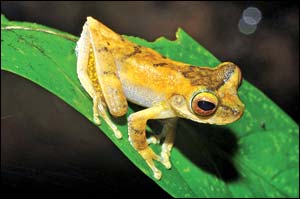Scientists discover new species
Scientists unveiled a spectacular array of more than 200 new species
discovered in the Pacific islands of Papua New Guinea, including a
white-tailed mouse and a tiny, long-snouted frog.
|

Beautiful member of the Litoria genimaculata group, a frog
with extremely variable colour patterns and distinct yellow
spots in the groin. AFP |

An undescribed species of montane mouse with white tail. AFP
|
The survey of remote New Britain island and the Southern Highlands
ranges, accessible only by a combination of small plane, dinghy,
helicopter and foot, found an exciting range of new mammals, amphibians,
insects and plants.
"To find a completely new genus of mammal in this day and age is
pretty cool," said lead researcher Steve Richards of the new mouse
species discovery.
"I mean, people have heard of birds of paradise and tree-climbing
kangaroos and stuff, but when you look even closer at the small things
you just realise that there's a staggering diversity out there that we
really know nothing about," he told AFP.
Papua New Guinea's jungles are one of just three wild rainforest
areas, along with the Amazon and the Congo basin, left in the world and
Richards said they were a vast "storehouse" of biodiversity, with scores
of new species found by his Conservation International team.
The "very, very beautiful mouse", the two-centimetre (0.8 inch) long-snouted
frog and another with bright yellow spots were among the highlights, but
the expedition documented 100 new species in each of the spider and
insect orders alone, he said.
"I would say that pretty much no matter where you go in New Guinea
you're guaranteed to pick up new or poorly known spectacular species,"
said Richards, an expert in frogs and reptiles who is based in Cairns,
Australia.
"For some lesser known groups only half of the things that we
document actually have names, we aren't even a fraction of the way
there," he added. The rugged, mountainous and largely inaccessible
terrain meant biologists had not even been able to enter some regions
and Richards said there were "large areas of New Guinea that are pretty
much unexplored biologically". Sample animals were taken of a number of
species, including the mouse, and genetic testing had confirmed that it
was not related to any known creature, he said.
"These kind of discoveries are almost kind of a good news story
amongst all the gloom," he said, referring to the creeping extinction of
other creatures.
"There really are spectacular species still out there and there
really is a potential for things to survive."AFP
|



